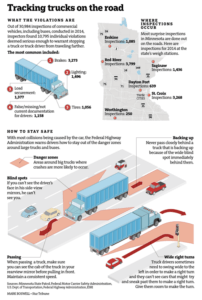Truck Accident Regulations Our MN Injury Lawyers Look At After A Crash
Our lawyers handle cases of a crash between a truck and a car in Minnesota. After the accident, Our truck accident injury attorneys look carefully at whether the truck complied with federal and state regulations. For example, inspection and maintenance of the semi-truck before the crash. Of course, there are also regulations for truck drivers such as periodic rest stops, sleep, etc. When our lawyers find violations of these trucking rules, it can explain the cause of a crash.
One of the Federal Regulations an experienced truck accident lawyer looks is CFR Section 396.
§ 396.3 Truck Inspection, repair, and maintenance.
(a) General. Every motor carrier and intermodal equipment provider must systematically inspect, repair, and maintain, all vehicles and equipment subject to its control.
(1) Parts and accessories shall be in safe and proper operating condition at all times. For example, those specified in part 393 of this subchapter. Also, any additional parts and accessories which may affect safety of operation. For example, frame and frame assemblies, suspension systems, axles and attaching parts, wheels and rims, and steering systems.
(2) In addition, pushout windows, emergency doors, and emergency door marking lights in buses shall be inspected at least every 90 days.
(b) Truck Required records.
Motor carriers, except for a private motor carrier of passengers (nonbusiness), must maintain records for each motor vehicle they control. Records must be kept for 30 consecutive days. Likewise, intermodal equipment providers must maintain records for each unit of intermodal equipment they tender to a motor carrier. These records must include:
(1) An identification of the vehicle including company number, make, serial number, year, and tire size. In addition, if the motor vehicle is not owned by the motor carrier, the record shall identify the name of the person furnishing the vehicle; (2) A means to indicate the nature and due date of the various inspection and maintenance operations to be performed; (3) A record of inspection, repairs, and maintenance indicating their date and nature; and (4) A record of tests conducted on pushout windows, emergency doors, and emergency door marking lights on buses.
Code of Federal Regulations / Title 49 – Transportation / Vol. 5 / 2009-10-01493
(c) Record retention. The records required by this section shall be retained where the vehicle is either housed or maintained for a period of 18 months after the motor vehicle leaves the motor carrier’s control. § 396.5 Lubrication. Every motor carrier shall ensure that each motor vehicle subject to its control is: (a) Properly lubricated; and (b) Free of oil and grease leaks. § 396.7
Unsafe operations forbidden. (a) General. A motor vehicle shall not be operated in such a condition as to likely cause an accident or a breakdown of the vehicle. (b) Exemption. Any motor vehicle discovered to be in an unsafe condition while being operated on the highway may be continued in operation only to the nearest place of repair. However, such operation shall be conducted only if it is less hazardous to the public than to permit the vehicle to remain on the highway.
§ 396.9 Inspection of motor vehicles and intermodal equipment in operation.
(a) Personnel authorized to perform inspections: Every special agent of the FMCSA (as defined in appendix B to this subchapter) is authorized to enter upon and perform inspections of a motor carrier’s vehicles in operation. (b) Prescribed inspection report: The Driver Vehicle Examination Report shall be used to record results of motor vehicle inspections.
(c) Motor vehicles and intermodal equipment declared “out-of-service.”
(1) Authorized personnel shall declare and mark ‘out-of-service’ any motor vehicle or intermodal equipment which by reason of its mechanical condition or loading would likely cause an accident or a breakdown. An ‘Out-of-Service Vehicle’ sticker shall be used to mark vehicles and intermodal equipment out-of-service. (2) In addition, no motor carrier or intermodal equipment provider shall require or permit any person to operate any vehicle declared out-of-service until all repairs have been satisfactorily completed.
The term “operate” as used in this section shall include towing the vehicle or intermodal equipment. However, vehicles or intermodal equipment marked ‘out-of-service’ may be towed away by means of a vehicle using a crane or hoist. A vehicle combination consisting of an emergency towing vehicle and an ‘out-of-service’ vehicle shall not be operated unless such combination meets the performance requirements of this subchapter.
(3) No person shall remove the Out-of-Service Vehicle sticker from any motor vehicle or intermodal equipment prior to completion of all required repairs.
(d) Motor carrier or intermodal equipment provider disposition.
(1) The driver of any motor vehicle who receives an inspection report shall deliver a copy to both the motor carrier operating the vehicle and the intermodal equipment provider upon his/her arrival at the next terminal or facility. However, if the driver is not scheduled to arrive at a terminal or facility of the motor carrier operating the vehicle or at a facility of the intermodal equipment provider within 24 hours, the driver shall immediately transmit the report to the motor carrier and intermodal equipment provider.
(2) Motor carriers and intermodal equipment providers shall examine the report. At that point, violations or defects noted thereon shall be corrected. Repairs of items of intermodal equipment placed out-of-service are also to be documented in the maintenance records for such equipment.
Code of Federal Regulations / Title 49 – Transportation / Vol. 5 / 2009-10-01494
(3) Within 15 days following the date of the inspection, the motor carrier or intermodal equipment provider shall: (i) Certify that all violations noted have been corrected. The Signature of Carrier/Intermodal Equipment Provider Official, Title, and Date Signed portions of the form must be completed; and (ii) Return the completed roadside inspection form to the issuing agency and retain a copy at the motor carrier’s principal place of business, or where the vehicle is housed for 12 months from the date of the inspection. [73 FR 76824, Dec. 17, 2008]
§ 396.11 Driver vehicle inspection report(s).
(a) Report required. (1) Motor carriers. Every motor carrier must require its drivers to report, and every driver must prepare a report in writing at the completion of each day’s work on each vehicle operated. The report must cover at least the following parts and accessories: Service brakes including trailer brake connections, Parking brake, Steering mechanism. Also, Lighting devices and reflectors, Tires, Horn, Windshield wipers. Also, Rear vision mirrors, Coupling devices, Wheels and rims, and Emergency equipment.
(2) Intermodal equipment providers. Every intermodal equipment provider must have a process to receive driver reports of defects or deficiencies in the intermodal equipment operated. The driver must report on, the following parts and accessories: King pin upper coupling device, Rails or support frames, and Tie down bolsters. Also, Locking pins, clevises, clamps, or hooks, Sliders or sliding frame lock. In addition, Wheels, rims, lugs, tires, Lighting devices, lamps, markers, and conspicuity marking material. Also, Air line connections, hoses, and couplers, Brakes.
(b) Report content.
The report shall identify the vehicle and list any defect or deficiency discovered by or reported to the driver. For example, anything which would affect the safety of operation of the vehicle or result in its mechanical breakdown. If no defect or deficiency is discovered by or reported to the driver, the report shall so indicate. In all instances, the driver shall sign the report. On two-driver operations, only one driver needs to sign the driver vehicle inspection report. However, both drivers must agree as to the defects or deficiencies identified. If a driver operates more than one vehicle during the day, a report shall be prepared for each vehicle operated.
(c) Corrective action.
Prior to requiring or permitting a driver to operate a vehicle, every motor carrier or its agent shall repair any defect or deficiency listed on the driver vehicle inspection report. (1) Every motor carrier or its agent shall certify on the original driver vehicle inspection report which lists any defect or deficiency that the defect or deficiency has been repaired or that repair is unnecessary before the vehicle is operated again.
(2) Every motor carrier shall maintain the original driver vehicle inspection report and the certification of repairs. In addition, the certification of the driver’s review for three months from the date the written report was prepared. (d) Exceptions. The rules in this section shall not apply to a private motor carrier of passengers (nonbusiness), a driveaway-towaway operation, or any motor carrier operating only one commercial motor vehicle. [44 FR 38526, July 2, 1979, as amended at 45 FR 46425, July 10, 1980; 53 FR 18058, May 19, 1988; 59 FR 8753, Feb. 23, 1994; 63 FR 33279, June 18, 1998; 73 FR 76824, Dec. 17, 2008].

TRUCK ACCIDENT VIOLATIONS MN INJURY LAWYER
Please call one of our top Minnesota attorneys right away for a free consultation if you were injured because of a car crash with a semi truck, tractor trailer or other type of truck. Pam Rochlin and David Rochlin are Minnesota personal injury lawyers with more than 25 years of experience. Our attorneys have successfully handled hundreds of auto and truck accident injury cases in MN. A best truck/car accident lawyer will discuss your case with you and explain your rights. We make sure you get the compensation you are entitled to.
Our lawyers will meet with you at our office or your home. A Minnesota semi truck accident lawyer will meet with you to discuss your auto accident case and injuries at our offices in Minneapolis, St. Louis Park, Woodbury, and Edina. Our attorneys also frequently meet with people and discuss their car accident with a truck case at their homes. Our lawyers come to Chanhassen MN, Chaska, Eden Prairie, Maple Grove MN, and Rogers MN. Also, Brooklyn Park, Forest Lake MN, Burnsville, Rogers, Apple Valley, Roseville, Maplewood, and other cities throughout Minnesota. There is no obligation on your part. Further, we always only charge a percentage of the compensation you receive. In other words you pay nothing until the settlement.
